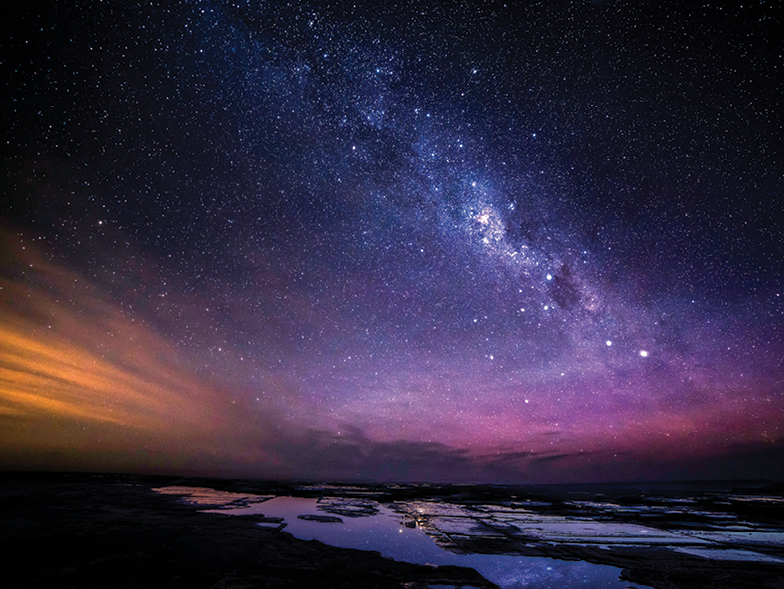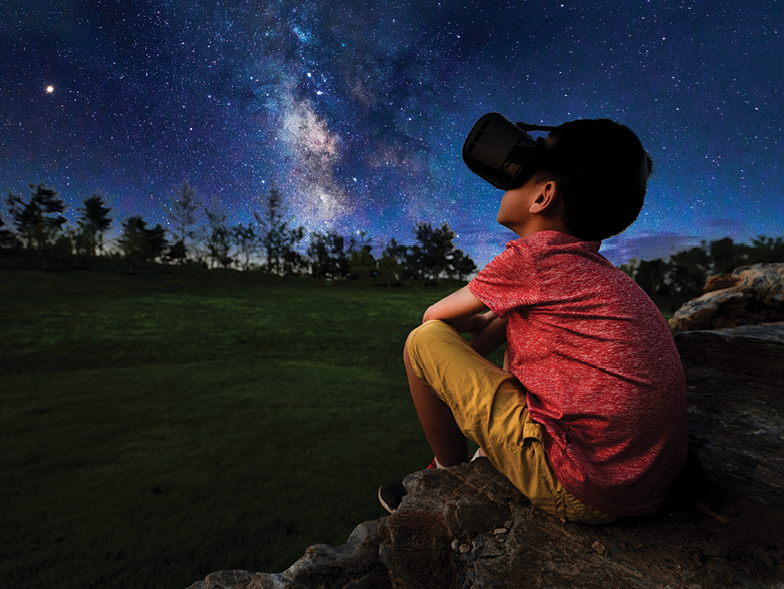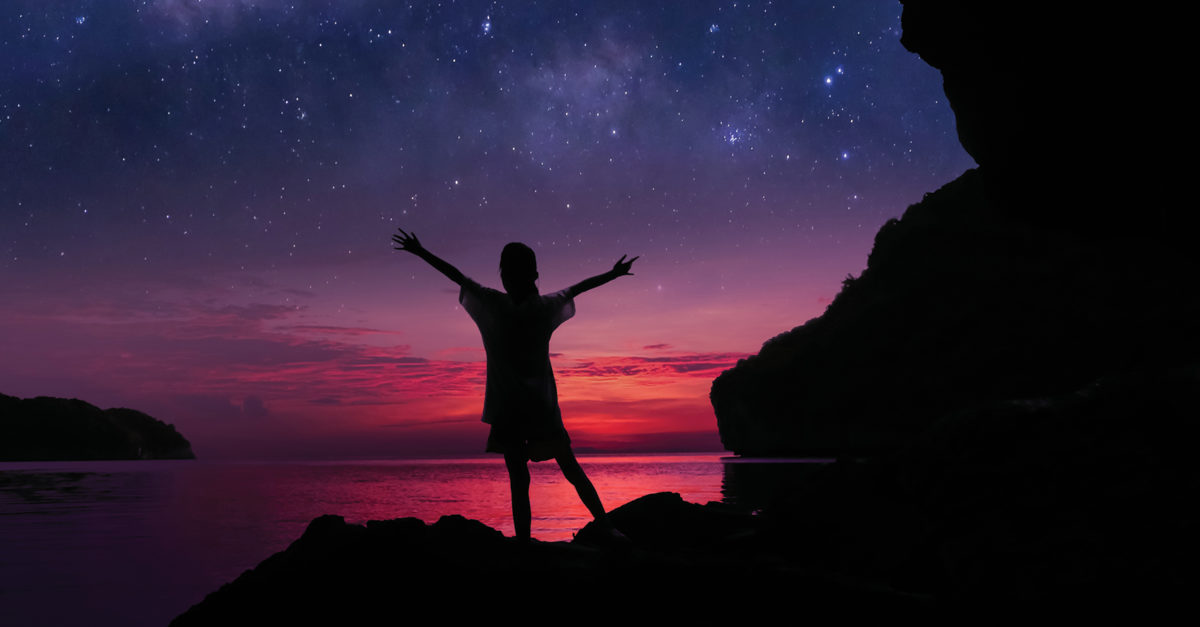The Serenity of Stargazing
Interview with: Bettymaya Foott
Bettymaya Foott, the director of engagement for the International Dark-Sky Association (IDA), reveals how light pollution affects our health, why we benefit from dark skies, and how stargazing is an intrinsically uniting phenomenon.

What is your personal experience with dark skies?
I grew up in a small town in rural Utah and spent my childhood summers looking up at the night sky and being astounded by the presence and vastness of the universe, which put my life in perspective. To me, the night sky has always been the ultimate mystery. As humans, we’re all connected to that sense of wonder and awe of the infinite cosmos.
When I moved to the big city for college, not having that was unsettling for me. I didn’t quite understand why because I had never heard the term “light pollution.” It wasn’t until I saw the film The City Dark that I learned what dark sky and light pollution were. Everything clicked, and I knew this is what I wanted to do.
What is light pollution? How long has it been an issue?
Light pollution is any adverse effect of artificial light at night. It comes in three main forms. Skyglow is the dome of light, caused by misdirected light scattering through the atmosphere above populated areas, that decreases the visibility of the night sky. The second form is glare. It’s like driving on a dark road at night and someone else’s high beams make it more difficult for you to see. The third form is light trespass: light from a neighbor or business that’s misdirected out of their property onto yours and into your home at night.
Light pollution has only occurred within the past 150 years. Before that, both humans and animals were connected to a very reliable cycle of light and dark. The addition of all this artificial light has had a huge impact on almost everything in the world.
How else can artificial light affect us?
Artificial light at night has been proven to trip up the human circadian rhythm (our sleep-wake cycle), which is mediated by the hormone melatonin. So when it’s getting dark at night and we’re no longer receiving the bright blue-white light from the sun, our body starts winding down to sleep and releases melatonin. But when we’re exposed to artificial light that mimics sunlight, it doesn’t.
Studies have also correlated it to other health issues like insomnia, depression, and even cancer. In addition, melatonin impacts our metabolism, so light pollution, artificial light, and exposure to light at night have been linked to obesity.

What are the health benefits associated with stargazing?
The experience of awe is underdiscussed and undervalued, but I think more people are connecting with it nowadays and realizing it’s important in their lives. Being under a naturally dark sky and seeing the Milky Way and all the stars is such an easy way of connecting with that feeling of awe, which is beneficial to mental and physical health.
Unfortunately, one-third of the global population lives under light pollution, so they can’t see the Milky Way at night. In the United States and Europe, that number is 99 percent. It’s very rare to be able to truly experience a dark sky, which is a huge worldwide issue, especially for cities.
It saddens me that it’s such a unique experience. We spend our day-to-day lives in these artificial worlds we’ve created for ourselves with boundaries and labels—I’m White, he’s Black, she’s a woman—that separate us from one another. But when you’re under a night sky and look up at the infinity and wonder of all the twinkling stars, you realize that we’re all in this together and those self-imposed divisions just melt away.
What can we do to make things better?
Everything matters. Even though light pollution varies throughout the world, the solutions are incredibly scalable. You can start at home by making sure your lighting isn’t shining into your neighbor’s window or up into the night sky and that you’re drawing your blinds at night when your inside lights are on.
You can then work on your city’s lighting. Adopting municipal lighting ordinances is probably the best way to ensure that your town complies with dark-sky-friendly lighting practices and ordinances, which we have on our website. It’s hard to get one passed, but it’s even harder to enforce it throughout a community because understaffing is always a problem. Municipalities also tend to underestimate the power of lighting and focus on other code-enforcement issues, such as OSHA violations. That’s why local volunteers and IDA chapters are important because you need someone on the ground to hold the city or county accountable for the lighting codes they’ve approved.
We’ve seen it work on a large scale. Pittsburgh just updated its lighting ordinance and will be replacing 35,000 streetlights to be dark-sky friendly, making it the first urban area in the world to take such impactful measures to reduce light pollution. New Mexico also has a dark-sky act that covers the entire state. New Zealand is working on national dark-sky conservation efforts, and Mexico officially recognizes light pollution as an environmental issue.
Is awareness key?
Totally. I think creating public awareness by building support for dark skies is the best way to go. Instead of saying “Here’s a new law! Change your lights or you’ll get a fine!” it’s better to say, “Hey, come out to this dark-sky party and look at Saturn through a telescope.” Most people don’t even know what light pollution is. Once you do, you can’t unsee it.
Are people attracted to the money-saving aspect of this issue?
Unfortunately, the Jevons Paradox often happens: when a resource becomes more efficient, it gets used more. For example, once LEDs became cheaper, cities put their cost savings into more lights for the community. Another problem is the people in charge of lighting aren’t experts like lighting designers or engineers. So when the LED revolution happened, people started switching bulbs on a one-to-one basis of wattage—if they had a 250- watt high-pressure sodium bulb, they’d put in a 250-watt, 5,000-Kelvin LED, which is a hundred times brighter.
That said, astrotourism is hugely beneficial to rural economic revitalization. To truly appreciate dark skies, you must spend the night in a town. And that increases a tourist’s spending fourfold: around $90 for a day visit versus $300 to $400 when you’re staying over. A Missouri State University study estimated that astrotourism would bring in $5.8 billion of economic funds and create over 10,000 jobs in the Colorado Plateau alone over a decade. It’s another great reason to protect dark skies in your area.
Overall, are you hopeful about the dark-sky movement?
In terms of connection to the night sky and dark-sky preservation, I’ve seen huge growth over the seven years I’ve been in the field. For my job, I’ve taken inquiries about the IDA from all over the world, including Aruba, Uzbekistan, and Iran. People everywhere are finding a connection to this issue and want to get involved and do something about it.
Fixing your lighting to be dark-sky friendly is a positive thing to do on many levels: you save money, energy, wildlife, and your health, and you reconnect to the night sky. In fact, light pollution is the only kind of pollution you can immediately remove from the environment instead of waiting for generations to see a change. It’s also a rare bipartisan political issue. Overall, I’ve found that it’s a very hopeful, unifying environmental topic because we all love the night sky and the stars.
For more info, visit darksky.org









